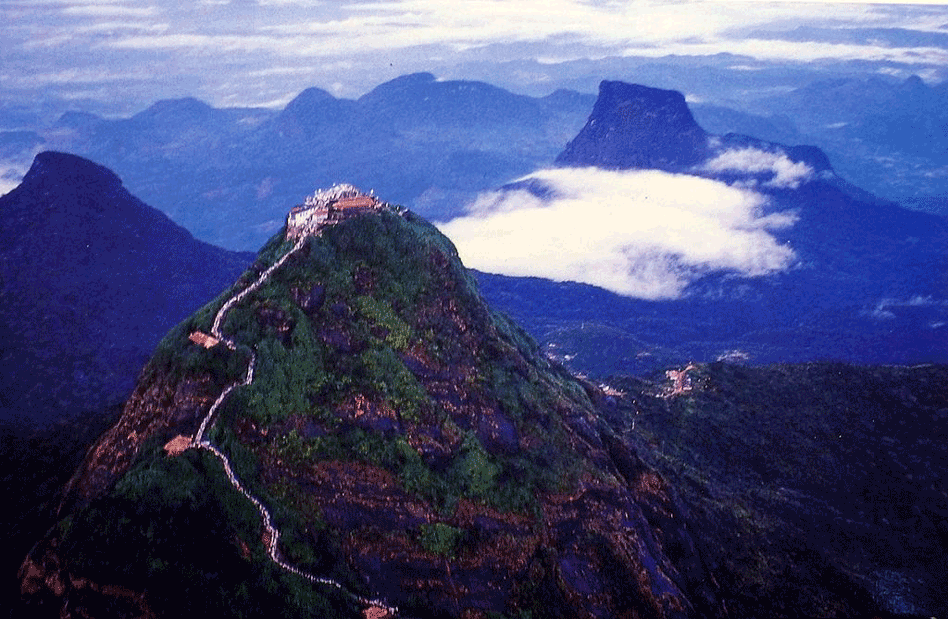Adam’s Peak
Table of Contents
- Where is Adam’s Peak?
- What is the importance of Adam’s peak?
- The nature of Adam’s peak
- Importance of Adam’s peak
- Historical Notes on Adam’s Peak
Where is Adam’s Peak?
Adam’s Peak is a mountain in southwestern Sri Lanka. It is 7,559 feet (2,304 meters) high and found 11 miles (18 km) northeast of Ratnapura, the capital of Sabaragamuwa province.
What is the importance of Adam’s peak?
It is notable for Sri Pada, an empty that is 67 inches (170 cm) long and 18 inches (46 cm) wide and looks like the print of a human foot. The Sri Pada is worshipped by Buddhists, Hindus, Christians, and Muslims. Numerous pilgrims of all religions visit the peak consistently.
The nature of Adam’s peak
Adam’s Peak isn’t the tallest mountain in Sri Lanka (that honour has a place with Pidurutalagala), yet it remains over the encompassing reach, and its cone-shaped shape provides it with the appearance of a pyramid. The locale encompassing Adam’s Peak is a tropical rainforest and incorporates the Peak Wilderness Sanctuary, made as a conservation zone in 1940. It is home to an elephant populace isolated from the lowland by the tea lands surrounding the jungle. Three significant rivers of Sri Lanka — the Kelani, the Walawe, and the Kalu — start at Adam’s Peak. The peak is made out of gneiss rock and is known for being wealthy in garnets, rubies, and sapphires.
Importance of Adam’s peak
The mountain was worshipped by the native people of Sri Lanka, who called it the Samanalakanda, Saman being one of the four guardian gods of the island. Hindus call the mountain Sivan Adi Padham, as they accept the god Shiva left a giant footprint on the top of the mountain. Buddhist traditions, reported in the Mahavamsa, show that the print was left by the Buddha during his third and last visit to Sri Lanka. A few Portuguese Christians, on their arrival in Sri Lanka in the sixteenth century, claimed the impression to be the footprint of St. Thomas, who, as per tradition, is accepted to have carried Christianity to Sri Lanka. Muslims accept it as the footprint of Adam, the mountain being the place where he remained standing on one foot for 1,000 years in the wake of being ousted from paradise.
Historical Notes on Adam’s Peak
An early notice of the Sri Pada dates to the reign of King Vijayabahu I (called Vijayabahu the Great), who was administered from 1055 to 1110 CE. Stone inscriptions at a site called Gilimale (or Gilimalaya) demonstrate that he committed the Gilimale town to accommodate the necessities of Buddhist pilgrims going to Sri Pada. He likewise settled wayside rest houses for pilgrims. King Nissankamalla (reigned 1187-96) had a substantial section developed to safeguard the footprint. Different later Sinhala Kings visited the mountaintop temple. Devaprathiraja, the priest of Lord Parakramabahu II (reigned 1225-69), developed streets paving the way to the mountain and introduced iron chains on iron presents to facilitate the ascent. Legends guarantee that the chains were placed there by Alexander the Incomparable, however, there is no evidence that he went as far south as Sri Lanka.
Adam’s Peak is referred to in writing and travelogues also. The sixth-century Tamil epic poem Manimekalai refers to the peak of Samantakuta on the island of Ratnadipa (“Island of Pearls”) as the site of the footprints of the Buddha. Adam’s Peak is additionally tracked down in the works of the pioneer Marco Polo and the explorer Ibn Battuta. The Tuhfat ul-Mujahidin, a book on the historical backdrop of Muslims in the Malabar district of India, credits their most memorable settlement in the country to a party of pilgrims getting back from Adam’s Peak. The fourteenth-fifteenth-century Chinese explorer Mama Huan portrays Adam’s Peak as abounding with rubies and valuable gemstones. Adam’s Peak started to be climbed and written about by an ever-increasing number of Europeans in the nineteenth century. The specialist and scientific expert John Davy, in an 1817 letter addressed to his more renowned sibling Sir Humphry Davy, specifies Adam’s Peak as having a lofty and on occasion troublesome course to the highest point and portrays the iron chains and rock steps that help pilgrims. He likewise endeavoured to gauge the level of the peak utilizing an indicator.






